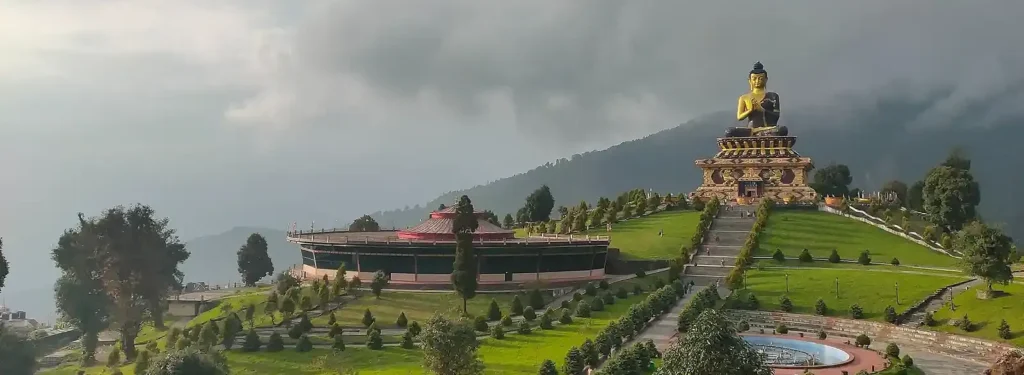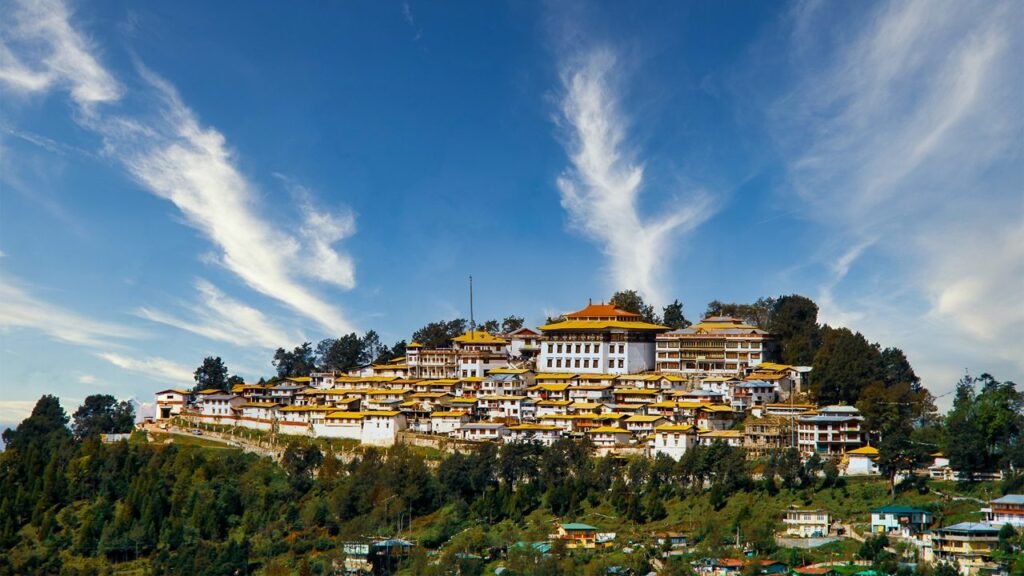Tawang Monastery, perched high in the misty Himalayas of Arunachal Pradesh, is far more than a religious monument, it is the beating heart of Monpa culture, a hub for spirituality, learning, and regional history. Revered as the largest monastery in India and the second-largest in the world, Tawang Monastery continues to inspire awe through its magnificent architecture, centuries-old traditions, and deep ties to Tibetan Buddhism.
Location and Setting
Located in the northwestern corner of Arunachal Pradesh, Tawang Monastery sits at 10,000 feet above sea level. Its strategic location, near the borders of Tibet and Bhutan, offers panoramic views of snow-clad mountains and the Tawang Chu valley, surrounded by coniferous forests and alpine vegetation. The nearest town, Tawang, is well connected by road, with the closest railway station in Bhalukpong (280 km away) and the nearest airport in Tezpur, Assam (350 km by road).
Key Details:
| Aspect | Details & Description |
|---|---|
| Location | Tawang, Arunachal Pradesh, India; in Tawang River Valley near borders of Tibet and Bhutan |
| Altitude | About 10,000 feet (3000 m) above sea level |
| Founded | 1680–1681, by Merak Lama Lodre Gyatso under 5th Dalai Lama’s guidance |
| Religious Affiliation | Gelugpa (Yellow Hat) sect of Tibetan Buddhism |
| Historical Importance | Oldest and largest monastery in India, second-largest in the world, spiritual hub and site of Dalai Lama visits |
| Architecture | Three-storey main complex, 925 ft long stone wall, Dukhang (main hall), golden Buddha statue, vibrant murals, 65 residential buildings |
| Number of Monks | Over 400-450 monks residing |
| Festivals | Torgya Festival, Losar (Tibetan New Year), regular prayer rituals |
| Library & Museum | Ancient Buddhist manuscripts (Kangyur, Tengyur), extensive library, and museum showcasing local heritage |
| Visiting Hours | 7:00 AM to 7:00 PM every day |
| Entry Fee | No entry fee; donations are welcomed |
| Suggested Visit Time | 2-3 hours for main monastery; 1-2 hours for each additional attraction |
| Best Visiting Season | March–October |
| Permits Required | Inner Line Permit (ILP) for all travelers to Arunachal Pradesh |
| How to Reach | By road from Tezpur/Guwahati; nearest airport/railway station at Tezpur (317 km), regular taxis & buses available |
| Cost of Travel | Budget tours (from Guwahati): ₹23,000–₹39,000 per person (7–10 days); 1-day tours: USD 80–100 per person; permits and special vehicle extra |
| Local Attractions | Urgelling Monastery, Sela Pass, Tawang War Memorial, Pangateng Tso Lake, Nuranang Waterfall |
| Food & Stay | Monastery café, nearby restaurants (Dragon Restaurant, Orange Lounge), multiple hotels & guest houses in Tawang town |
| Conservation Issues | Occasional landslide risk, efforts by local government to protect site |
A Living Monument: Architecture and Layout
Constructed in the year 1680-81 by Merak Lama Lodre Gyatso on the wishes of the 5th Dalai Lama, Tawang Monastery is a three-story architectural marvel. The complex is surrounded by a 925-foot stone wall, encompassing 65 residential quarters, educational institutions, prayer halls, and a grand assembly hall, the Dukhang, which features an 18-foot gilded statue of Buddha. The inner sanctum boasts ancient manuscripts like the Kangyur and Tengyur, exquisite thangkas, and murals depicting Buddhist deities and historical events.
History: A Legacy from the 17th Century
Tawang Monastery’s establishment is steeped in legend. According to lore, the site was divinely chosen when Merak Lama’s horse guided him to the spot after prayers for spiritual guidance. Since its construction, the monastery has survived invasions, political upheaval, and the challenges of remoteness. Its close ties with the Dalai Lama, particularly during the latter’s escape from Tibet in 1959, have made the monastery a symbol of resilience and continuity in Tibetan Buddhism.
Culture: The Heart of Monpa Life
Tawang’s rich cultural tapestry is intricately interwoven with Buddhist philosophy. The Monpa community, followers of the Gelug sect, celebrate major festivals such as Choksar, Losar (Tibetan New Year), and Torgya with vibrant rituals, mask dances, and processions that attract thousands. The monastery is central to Monpa identity, not just a place of worship but a center for education, cultural preservation, and community gatherings.
Monastic Life and Education
Around 400 lamas currently reside at Tawang Monastery, pursuing spiritual studies and monastic education. Its library and learning centers play a crucial role in preserving Buddhist texts and teaching Buddhist philosophy, languages, and scriptures to the younger generation.
Attractions for Visitors
Tawang Monastery is the centerpiece of a circuit that includes sacred sites like the Urgyelling Monastery (birthplace of the 6th Dalai Lama), Tipi Orchid Sanctuary, Sela Pass, and the picturesque Madhuri Lake. The region’s natural beauty and serene atmosphere provide a unique blend of eco-tourism and spiritual retreat.
Festivals and Events
Annual festivals held at the monastery, especially the Torgya Festival, feature cham mask dances, rituals for warding off evil, and communal feasts. The Losar festival marks the Tibetan New Year with multi-day celebrations, drawing Monpas and tourists alike for blessings and festivities.

Recent Developments and News
Tawang Monastery remains at the center of international Buddhist discourse. In July 2025, the Dalai Lama affirmed that his reincarnation would not be born in Chinese-controlled Tibet, making Tawang pivotal amid global interest in the succession. This news has increased global pilgrimage interest and reinforced Tawang’s stature in Tibetan Buddhism.
Route and Accessibility
- By Air: The nearest airport is in Tezpur, Assam, with regular taxi and bus services to Tawang.
- By Rail: Bhalukpong is the closest railhead; travelers can continue via bus/taxi.
- By Road: Tawang is accessible from Guwahati or Tezpur by scenic routes passing Sela Pass and Jaswant Garh.
- Inner Line Permit: All visitors require an Inner Line Permit (ILP) to enter Arunachal Pradesh.
Revenue and Tourism Trends
Tawang Monastery draws tens of thousands of pilgrims and tourists annually. The site saw a sharp rise in tourist arrivals post-pandemic, reaching 73,219 visitors in 2023, with a large majority being domestic travelers. Tourism brings essential revenue to local communities, supporting hotels, guides, shops, and cultural events. Visitors come for religious worship, natural beauty, recreation, and to experience the unique blend of spirituality and culture Tawang offers.
Conservation and Sustainable Tourism
Due to its unique blend of ecology and culture, there is ongoing effort to develop sustainable tourism, ensuring visitors respect the heritage and fragile environment of this sacred landscape.
FAQs About Tawang Monastery
What is the historical significance of Tawang Monastery?
Tawang Monastery was founded in 1680-81 and has since served as the primary seat of Buddhism in Arunachal Pradesh, playing a central role in the region’s religious and cultural life.
Can tourists visit the monastery? What are its visiting hours?
Yes, tourists are welcome. Visiting hours typically run from sunrise to sunset, but respectful dress and decorum are required as it is an active monastery.
Which festivals should visitors experience at Tawang Monastery?
The most popular festivals are Torgya, held exclusively at the monastery, Losar (Tibetan New Year), and Choksar, each featuring spiritual rituals, music, and dance.
How do travelers reach Tawang Monastery?
Travellers can reach Tawang by air (Tezpur), rail (Bhalukpong), or road via scenic mountain highways. Obtaining an Inner Line Permit (ILP) is mandatory to enter Arunachal Pradesh.
How does Tawang Monastery contribute to the local economy?
Tourism associated with the monastery supports local hospitality businesses, handicrafts, food vendors, and guides. The site’s growing popularity, especially after recent global religious developments, has further boosted local revenue.
What is the architectural style of Tawang Monastery?
It follows a traditional Tibetan layout, with stone walls, intricate murals, vibrant thangkas, a grand Dukhang (assembly hall), and beautiful golden Buddha statue.
Why is Tawang Monastery important for the Dalai Lama’s succession?
Tawang Monastery holds spiritual authority in the Gelug tradition and is outside Chinese rule, making it a credible site for significant religious decisions, such as the recognition of the next Dalai Lama.
Conclusion
Tawang Monastery stands as a shining symbol of Buddhism’s endurance, Monpa culture, and the living heritage of Arunachal Pradesh. From breathtaking mountain vistas and sacred traditions to its emerging global significance, this sacred site invites travelers and pilgrims to witness spirituality, hospitality, and Himalayan grandeur.
Recent News and Perspectives
In recent months, Tawang Monastery has become a focal point in international religious and geopolitical narratives. The Dalai Lama’s announcement in July 2025, declaring Tawang a likely site for the recognition of his reincarnation, has spurred diplomatic debates between India and China over the monastery’s significance and future. As a result, there is renewed interest from global pilgrims and international media, with visitor numbers expected to rise dramatically.
Local authorities have responded by enhancing conservation efforts, investing in infrastructure, and launching new cultural festivals, such as the Shangri La Calling Festival in October 2025, designed to celebrate Monpa heritage while promoting sustainable tourism. This resurgence reinforces Tawang Monastery’s unique position as a spiritual beacon, cultural sanctuary, and vital contributor to regional and global Buddhist heritage.
With such rich history, vibrant cultural life, and a crucial role in defining the future of Tibetan Buddhism, Tawang Monastery remains one of the most awe-inspiring and consequential Buddhist landmarks in the world.
